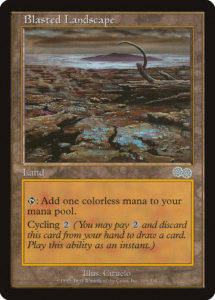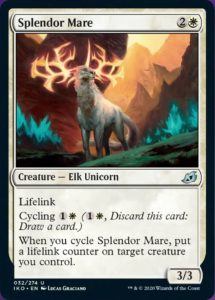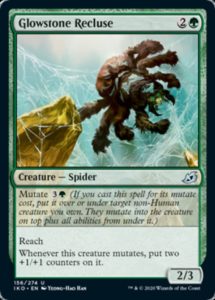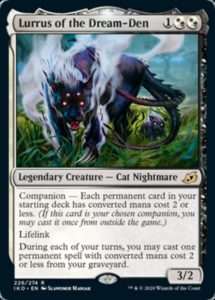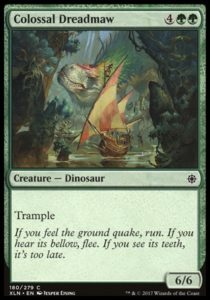Ikoria’s digital prerelease is next week (meaning it basically releases next Thursday) and it’s one of the wildest looking sets this side of Time Spiral block. It features one returning mechanic and three brand new ones. Today, we’ll investigate all four, starting with one of Magic’s most frequently used non-evergreen mechanics.
Recycling one of the best mechanics
Cycling is an outstanding mechanical tool. While essentially devoid of flavor, it does wonders for a format. It’s one of Magic’s best smoothing mechanics—by letting you hit land drops early, play a higher density of threats (and situational cards), and draw gas late, it helps reduce the number of non-games where one player doesn’t get to play. It’s skill-testing without being complicated, threading the difficult needle of lenticular design.
The challenge of putting Cycling into a set is that it has been used so often, in so many different ways, that’s it harder to innovate upon. We’ve seen cards cycle for varying amounts of colorless and colored mana (Smoldering Crater, Forgotten Cave, Desert of the Fervent); abilities trigger upon cycling (Renewed Faith, Gempalm Avenger, Archfiend of Ifnir); Cycling-matters cards (Astral Slide, New Perspectives, Abandoned Sarcophagus); Cycling for specific kinds of cards (Chartooth Cougar, Fiery Fall, Homing Sliver); Cycling to amplify a spell’s effect (Resounding Scream) or diminish its effect (Decree of Pain); we’ve even seen mechanics based on Cycling produce non-card effects (Ghost-Lit Warder, Hunting Triad).
Cycling is an awesome mechanic, but as a workhouse mechanic in a deeply mined design vein, it’s harder for it to wow players or sell a set. We’re seeing some new twists on Cycling’s design space, like adding ability counters; but perhaps the biggest Cycling innovation in Ikoria is also the simplest: several cards cycle for just a single generic mana. We’ve never seen Cycling that easy (outside of Street Wraith, and that card is nuts). I wonder if this buff is due to the steady upward creep in common creature power—if two drops can be serious threats, spending two whole mana to Cycle a card can be a liability. We’ll see just how good it turns out to be, but I’m excited to get to Cycle through my deck again.
The Return of Punch Out
Ability counters are fairly simple to understand—you put a Flying counter on a creature, now it has flying. That’s simple enough. Heck, it made sense on Recycla-bird before we knew it was a future-shifted card (like Enchantmentize and One with the Stars).
I worry what ability counters will do to battlefield complexity. Magic has long been careful to only have one type of counter per set that can be placed on a variety of creatures (since people tend to struggle to distinguish one penny or die’s meaning from another’s). Their solution is to return to the punch out technology of Amonkhet (back when you needed to track states like being Exerted or Embalmed), so you can have clear indicators of the ten modifications creatures will have. This will likely be much cleaner in digital Magic when you always have the right counter, counters can’t slide or be blown off a creature, and you get visual indications like a creature floating above the battlefield in Magic Arena. In fact, that seems to be the rule for every new mechanic in Ikoria—they all have some awkward component that digital Magic addresses.
It’ll be some time before we get to play with physical Ikoria ability counters, but I’m curious to see how easy it is to parse a battlefield with several different counters in play. Players often make mistakes by forgetting some bit of a text on an aura or spell, and I wonder how much easier or harder it will be to remember that a creature has a Deathtouch counter and another has a Reach counter.
The Non-Human Elephant Nightmare in the Room
Mutate is one of the most complicated Magic mechanics I’ve ever seen (this side of Morph). It’s like a mashup of Bestow and Augment with a dash of Emerge and the nitpicky nuances of Soulbond, bearing far more rules than can fit on the card. At its core, Mutate is a modal mechanic—you choose between a creature and an aura-like effect. Unlike Bestow, this is an actual choice. Where Bestow is all-upside and essentially fail-proof (so you should always Bestow when you have the choice), Mutating invites the risk of card disadvantage. Mutate encourages you to engage with this risk by having when-this-Mutates effects on all Mutate creatures, giving you reason to Mutate the same creature multiple times. This design encourages players to think critically about when they Mutate rather than always do so, making it more skill-intensive but accordingly harder to play with.
The potency of Mutate varies based removal and cheap creatures. Cards like Suntail Hawk and Slither Blade make Mutate better, since they are powerful foundations to Mutate onto and attack with (since most Mutate costs are cheaper than casting the creature normally). On the other hand, Pacifism and Blood Curdle being high quality common removal in the set make it riskier to go tall on a single threat. It’s also worth noting that you get diminishing returns for Mutating multiple times—the first Mutation likely involves a hefty upgrade to a creature’s stats, while subsequent ones are probably defined more by getting value from multiple when-this-Mutates abilities.
As with Ability counters, Mutate seems designed for the digital age of Magic. There are plenty of rules questions or mistakes that seem likely to happen as people become familiar with the mechanic, and the set includes cards like Tentative Connection and Escape Protocol that might otherwise be excluded for the confusion they’d cause. While the present tragic circumstances sadly make Arena and Magic Online the sole platforms for Ikoria in the immediate term, Ikoria seems like it was designed more for the age of digital Magic than any other set. I’m curious to see whether or how this trend continues in the next few releases—is Ikoria an experiment in a possible future or a harbinger of more digital-focused Magic coming round the bend?
A New Kind of Commander
It isn’t often that a named mechanic only appears at rare (Hideaway in Lorwyn is one of the few such examples), but Companion makes sense. It’s incredibly powerful and like Mutate, involves far more rules text than can fit on the card. As a rare-only mechanic, Companion is clearly intended more for Constructed than it is Limited. In Limited, it presents an interesting draft challenge with a major reward, whereas in Constructed, it provides the benefit of a Commander (that you can only cast once) or an eighth card that always starts in your hand—if you can jump through its hoop.
Depending on how you look at it, Companion could be ludicrously powerful (having this much control over every opening hand is crazy strong) or overly restrictive (many of these conditions seem onerous, especially for Standard). It’s also one of the more mentally taxing mechanics for paper tournament play, since a revealed Companion puts the onus on both players to regularly verify that the condition is not violated (something that seems likely to become an accidental issue post-sideboarding in draft). Magic already has a mechanic that requires vigilance in paper rules enforcement (Morph), but Companion seems a lot easier to play with digitally (which seems to be a major theme with Ikoria).
Mechanics with scant precedent in Magic are especially difficult to evaluate, and Companion fits the bill. I could see cards like Lurrus or Lutri redefining and dominating Constructed formats, and I could see Standard mostly passing them by. We simply have never seen anything quite like them, and that’s both exciting and frightening—especially considering the wild swings in power level we’ve seen over the past few sets.
Ikoria looks wild and experimental. Its complexity is high enough that it seems to rely upon digital Magic more heavily than any previous set. I expect it to be a fairly polarizing set where its fans love it and its detractors can’t stand it. It’s also on awkward footing at the get-go, since current circumstances force it to be digital-only outside of the APAC region for the time being. This could be a boon for the set (since everyone’s stuck at home and able to get in more time on Arena) or do it undeserved damage (since people can’t play it in person with their friends). If Ikoria is a miss, I worry that players like me (who don’t care much for Core Sets or Commander) might fall off the Magic wagon until Zendikar arrives half a year from now. If it’s a hit, it could usher in a new era of silliness, complexity, digital-focused Magic, and IP partnerships. Time will tell, and Ikoria’s going to be arriving with a bang in just over a week.
And, as always (and especially in these times), thanks for reading.
—Zachary Barash is a New York City-based game designer and the commissioner of Team Draft League. He designs for Kingdom Death: Monster, has a Game Design MFA from the NYU Game Center, and does freelance game design. When the stars align, he streams Magic (but the stars align way less often than he’d like).

